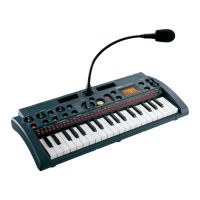microSAMPLER
36
The microSAMPLER lets you choose one of twenty-one different types of
full-digital effects. These effects are categorized as follows.
1. Effect inputs and outputs
In the DRY/WET balance, the “DRY” signal (the direct sound unprocessed
by the effect) will output the stereo input as stereo output without any pro-
cessing. The way in which the WET signal (the signal processed by the
effect) is output will depend on the type of effect; the three possibilities are
shown below.
The block diagrams in the table above show the input/output configuration
for each effect type.
In order to obtain the best audio quality, adjust the input level to the effect
by using the sampling parameter LEVEL (☞p.24) and each effect’s TRIM
parameter so that the level is as high as possible without clipping. Then use
the effect’s DRY/WET balance and OUT.LEVEL setting to adjust the output
level of the effect.
Some effect types do not have TRIM, OUT.LEVEL, or DRY/WET parameters.
There is no input level meter that indicates the input level to the effect. If the
input level is insufficient, the signal/noise ratio will be poor. If the input level
is excessive, clipping will occur.
2. Controlling effect parameters
You can use the front panel [PARAMETER/FX CONTROL 1] knob and
[VALUE/FX CONTROL 2] knob to control effect parameters in realtime.
The parameters assigned to these knobs can also be controlled from an exter-
nal MIDI device.
Noise may be heard if a parameter to which a knob cannot be assigned is
operated during playback.
The parameters that can be assigned will depend on the effect that type
you’re using.
For details on how to assign a parameter to a knob, please refer to “1. Using
an effect” (☞p. 19).
3. About the delay time
TM RATIO (Time Ratio)
For delay effects, the actual delay time will be the delay time setting multi-
plied by the “TM RATIO” setting.
For example:
• If BPM SYNC: “OFF,” L DELAY: “800 ms,” R DELAY: “400 ms,” and TM
RATIO: “50%,” the actual delay will be “400 ms” for the left channel and
“200 ms” for the right channel.
• If BPM SYNC: “ON,” L DELAY: “ 1/4,” R DELAY: “ 1/8,” and TM
RATIO: “50%,” the actual delay time will be “1/8” for the left channel
and “1/16” for the right channel.
Delay time when BPM SYNC is off
If BPM SYNC is off, you can specify the delay time in msec (millisecond)
units.
If the delay time multiplied by TM RATIO would exceed the allowable range
of the setting, a “ ” symbol is shown at the right of the TM RATIO and delay
time value, and the delay time will be the maximum allowable value.
About the effect processor
Filter and dynamics effects Compressor, Filter, 4Band EQ, Distortion, Decimetor
Reverb and delay effects Reverb, Delay, L/C/R Delay, Auto Panning Delay, Modu-
lation Delay, Tape Echo
Pitch and modulation
effects
Chorus, Flanger, Vibrato, Phaser, Tremolo, Ring Modu-
lator, Grain Shifter, Pitch Shifter, Talking Modulator,
Looper
WET
L
R
L
R
L
R
Mono In - Mono Out
Mono In - Stereo Out
Stereo In - Stereo Out
Effect
Effect
Effect
Effect

